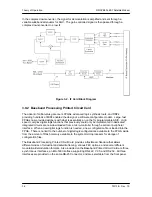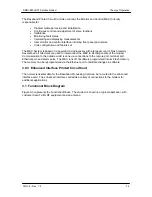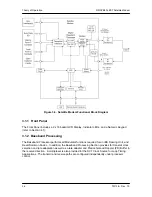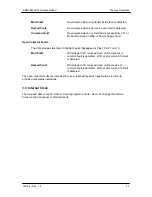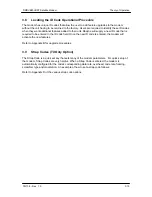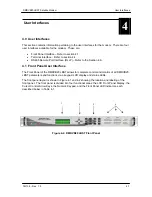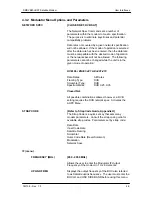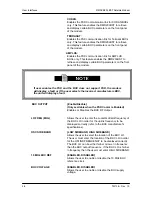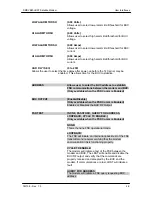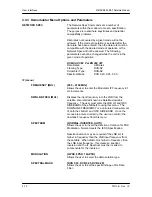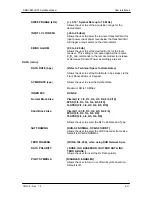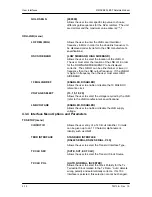
DMDVB20 LBST Satellite Modem
Theory of Operation
TM138 – Rev. 1.0
3-13
3.7 Reed-Solomon Codec (TX Only)
Reed Solomon only pertains to TX options.
Refer to Figures 3-8, 3-9, and Table 3-1.
Utilizing a Reed-Solomon (R-S) Outer Codec concatenated with a Convolutional Inner Codec is
an effective way to produce very low error rates even for poor signal-to-noise ratios while
requiring only a small increase in transmission bandwidth. Typically, concatenating an R-S
Codec requires an increase in transmission bandwidth of only 9 – 12% while producing a greater
than 2 dB improvement in E
b
/N
o
. R-S is a block Codec where K data bytes are fed into the
encoder which adds 2t = (N – K) check bytes to produce an N byte R-S block. The R-S decoder
can then correct up to “t” erred bytes in the block.
3.7.1 Reed-Solomon Operation
When the Reed-Solomon Codec is enabled, data is fed to the R-S Encoding Section where it is
scrambled, formed into blocks, R-S encoded, and interleaved. Unique words are added so that
the blocks can be reformed in the Receiving Modem (Refer to Figures 3-7 and 3-8). Data is then
sent to the modulator where it is convolutionally encoded, modulated and transmitted to the
satellite.
When the signal is received and demodulated by the Receiving Modem, it is fed to a Viterbi
Decoder for the first layer of error correction. After error correction is performed by the Viterbi
Decoder, the unique words are located and the data is deinterleaved and reformed into blocks.
The R-S Decoder then corrects the leftover errors in each block. The data is then descrambled
and output from the R-S Section.
3.7.2 Reed-Solomon Code Rate
The R-S Code Rate is defined by (N, K) where N is the total R-S block size in bytes - data +
check bytes - and K is the number of data bytes input into the R-S Encoder. The transmission
rate expansion required by the R-S Codec is then defined by N/K. The modem automatically sets
the correct R-S code rate for IBS open network operation in accordance with the data shown in
Table 3-1. The modem allows the following N and K setting: (126, 112), (219, 201), (194, 178),
(225, 205).
Variable Reed-Solomon rates are available on the optional AS/5167 Super Card. Refer to
Appendix A for further information.
3.7.3 Interleaving
Interleaving depths of 4, 8, or 12 R-S blocks are allowed. This allows burst errors to be spread
over multiple blocks in order to enhance the error correcting performance of the R-S Codec. For
Intelsat Network Modes, the interleaving depth is automatically set to 4 for QPSK or BPSK, or 8
for 8PSK. In Closed Network Mode, the interleaver depth can be manually set to 4 or 8, and in
DVB Network Mode, the interleaver depth is automatically set to 12.
Summary of Contents for DMDVB20 LBST
Page 11: ...Table of Contents DMDVB20 LBST Satellite Modem xii TM138 Rev 1 0...
Page 14: ...DMDVB20 LBST Satellite Modem Introduction TM138 Rev 1 0 1 3...
Page 20: ...Installation DMDVB20 LBST Satellite Modem 2 6 TM138 Rev 1 0...
Page 36: ...Theory of Operation DMDVB20 LBST Satellite Modem 3 16 TM138 Rev 1 0...
Page 67: ...DMDVB20 LBST Satellite Modem User Interfaces TM138 Rev 1 0 4 31...
Page 73: ...Rear Panel Interfaces DMDVB20 LBST Satellite Modem 5 6 TM138 Rev 1 0...
Page 79: ...Maintenance and Troubleshooting DMDVB20 LBST Satellite Modem 6 6 TM138 Rev 1 0...
Page 88: ...DMDVB20 LBST Satellite Modem Technical Specifications TM138 Rev 1 0 7 9...
Page 90: ...Appendix A DMDVB20 LBST Satellite Modem A 2 TM138 Rev 1 0...
Page 97: ...DMDVB20 LBST Satellite Modem Appendix B TM138 Rev 1 0 B 7...
Page 100: ...DMDVB20 LBST Satellite Modem Appendix C TM138 Rev 1 0 C 3...
Page 107: ...DMDVB20 LBST Satellite Modem Appendix D TM138 Rev 1 0 D 7...




